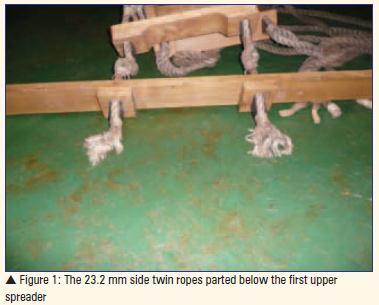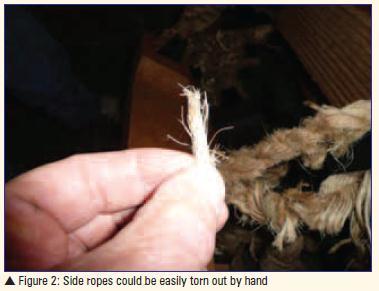201048 Pilot fell overboard due to ladder ropes parting
Pilot fell overboard due to ladder ropes parting
MARS Report 201048
After unberthing a bulk carrier, the pilot disembarked via a Solas-approved pilot ladder that was supplied about 30 months earlier and appeared to be in good condition. The master reported that this was the ship's newest pilot ladder. Earlier, the duty officer confirmed its safe rigging to the bridge and stood by at the location to supervise the pilot transfer.
As soon as the pilot had climbed down the first few steps, the right side ropes parted without any warning and an instant later, the left side ropes parted as well. The pilot and the lower section of the ladder fell into the water between the ship, which was moving ahead at about five knots, and the pilot boat. The master immediately stopped the engine. Fortunately, despite being struck lightly by the pilot boat and scratched by the ship's hull, the pilot did not sustain any serious injury and was quickly rescued from the water by the pilot boat's crew. The main ladder section was recovered from the water and examined by a laboratory ashore.


During investigations, it was established that the ladder was manufactured in 2004, as stated in the Solas type-approval certificate, and it was supplied to the vessel in a US port in early 2008. The ladder was normally stowed in the bosun's store, on a pallet close to hydraulic pumps; but it was not contaminated either with oil or chemicals.
The ladder's side ropes consisted of twin 23.2 mm diameter continuous ropes passing through holes drilled into the steps and whipped together above and below each step. The side ropes, the tails and the whipping ropes were of uncovered natural fibre. The steps looked new; only one face was scratched. The side ropes below the break showed strong traces of rubbing on almost all step intervals and the side ropes, as well as tails and whipping ropes, could be easily torn out by hand. The breaking test revealed that the strength of the side ropes had reduced to about 160 kilogram force (kgf) instead of the normal 3,500 kgf for a new manila rope of that size.
Microscopic examination showed that the ropes used were sisal, a fibre about 10 per cent weaker than manila, and infested with micro-organisms, which had steadily weakened the fibre after the ladder's manufacture and during storage, either on board or ashore.
Editor's note: To ensure safety, the deck crew must be trained to detect and report faults in pilot ladders. Additionally, the ship's officer attending pilot transfer on the deck should put on a suitable fall-arresting device and test the strength of the ladder by standing on the steps. In many ports, such as Singapore, the pilot will only board after witnessing this ladder test by a ship's crew member.
